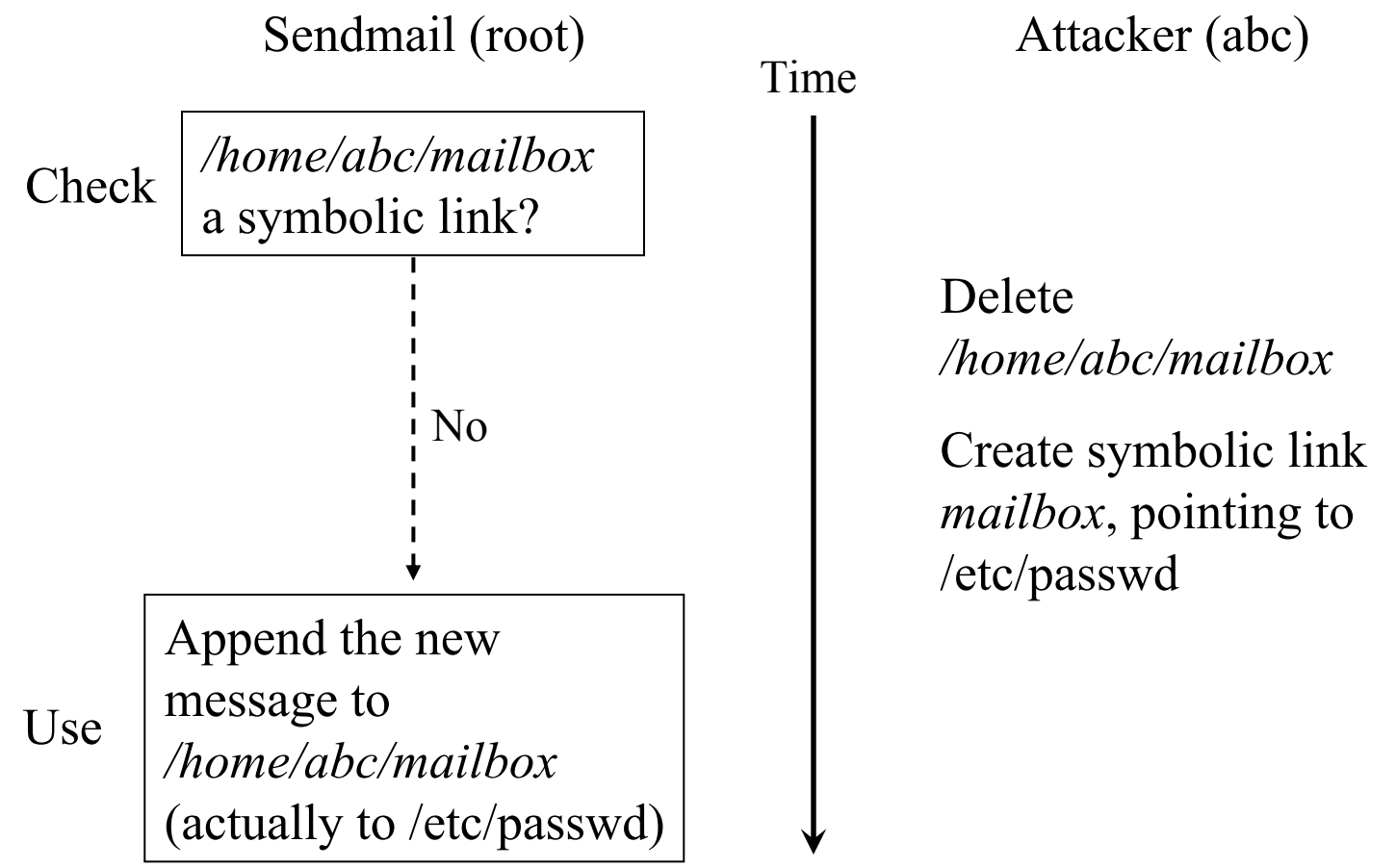https://jyywiki.cn/OS/2022/slides/8.slides#/4/3
- “TOCTTOU” - time of check to time of use

https://www.usenix.org/legacy/events/fast05/tech/full_papers/wei/wei.pdf
ABSTRACT
Due to their non-deterministic nature, Time of Check To Time of Use (TOCTTOU) vulnerabilities in Unixstyle file systems (e.g., Linux) are difficult to find and prevent. We describe a comprehensive model of TOCTTOU vulnerabilities, enumerating 224 file system call pairs that may lead to successful TOCTTOU attacks. Based on this model, we built kernel monitoring tools that confirmed known vulnerabilities and discovered new ones (in often-used system utilities such as rpm, vi, and emacs). We evaluated the probability of successfully exploiting these newly discovered vulnerabilities and analyzed in detail the system events during such attacks. Our performance evaluation shows that the dynamic monitoring of system calls introduces non-negligible overhead in microbenchmark of those file system calls, but their impact on application benchmarks such as Andrew and PostMark is only a few percent.
Categories and Subject
Descriptors D.4.3: File Systems Management – Access methods; D.4.5: Reliability –verification; D.4.6: Security and Protection – Access controls.
General Terms
Reliability, Experimentation, Security.
Keywords
Race detection
1 Introduction
TOCTTOU (Time Of Check To Time Of Use) is a well known security problem [1] in file systems with weak synchronization semantics (e.g., Unix file system). A TOCTTOU vulnerability requires two steps [2]. First, a vulnerable program checks for a file status. Second, the program operates on the file assuming the original file status remained invariant during execution. For example, sendmail may check for a specific attribute of a mailbox (e.g., it is not a symbolic link) in step one and then append new messages (as root) in step two. Because the two steps are not executed atomically, a local attacker (mailbox owner) can exploit the window of vulnerability between the two steps by deleting his/her mailbox and replacing it with a symbolic link to /etc/passwd. If the replacement is completed within the window and the new messages happen to be syntactically correct /etc/passwd entries with root access, then sendmail may unintentionally give unauthorized root access to a normal user (the attacker).
TOCTTOU vulnerabilities are a very significant problem. For example, between 2000 and 2004, we found 20 CERT [14] advisories on TOCTTOU vulnerabilities. They cover a wide range of applications from system management tools (e.g., /bin/sh, shar, tripwire) to user level applications (e.g., gpm, Netscape browser). A similar list compiled from BUGTRAQ [16] mailing list is shown in Table 1. The CERT advisories affected many operating systems, including: Caldera, Conectiva, Debian, FreeBSD, HP-UX, Immunix, MandrakeSoft, RedHat, Sun Solaris, and SuSE. In 11 of the CERT advisories, the attacker was able to gain unauthorized root access. TOCTTOU vulnerabilities are widespread and cause serious consequences.
Table 1: Reported TOCTTOU Vulnerabilities
Domain Application Name
Enterprise applications
Apache, bzip2, gzip, getmail, Impwebmail, procmail, openldap, openSSL, Kerberos, OpenOffice, StarOffice, CUPS, SAP, samba
Administrative tools
at, diskcheck, GNU fileutils, logwatch, patchadd
Device managers
Esound, glint, pppd, Xinetd
Development tools
make, perl, Rational ClearCase, KDE, BitKeeper, Cscope
At the same time, TOCTTOU vulnerabilities are also a very challenging research problem due to their non-deterministic nature. They are very hard to detect because the occurrence of a TOCTTOU vulnerability requires a pair of certain system calls along the execution path of an application combined with appropriate environmental conditions. So they are more elusive than say, a buffer overflow bug which is only a single point of failure. TOCTTOU vulnerabilities are also hard to exploit, because they are essentially race condition errors so whether an attack can succeed relies on whether the attacking code is executed within the usually narrow window of vulnerability (on the order of milliseconds as shown in section 4.2). Furthermore, normal static program analysis tools for detecting race conditions cannot be applied directly, since the attack programs are usually unavailable until the vulnerabilities are discovered.
标签:use,vulnerabilities,system,detection,TOCTTOU,file,time,tools From: https://www.cnblogs.com/rsapaper/p/16805073.html